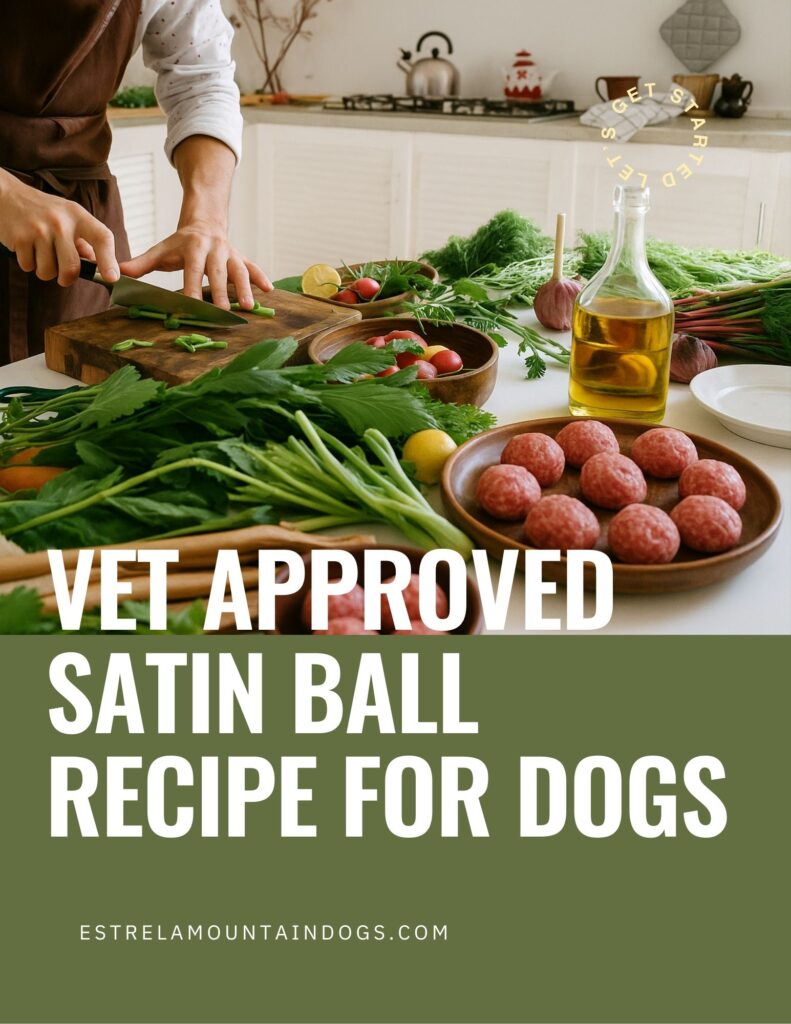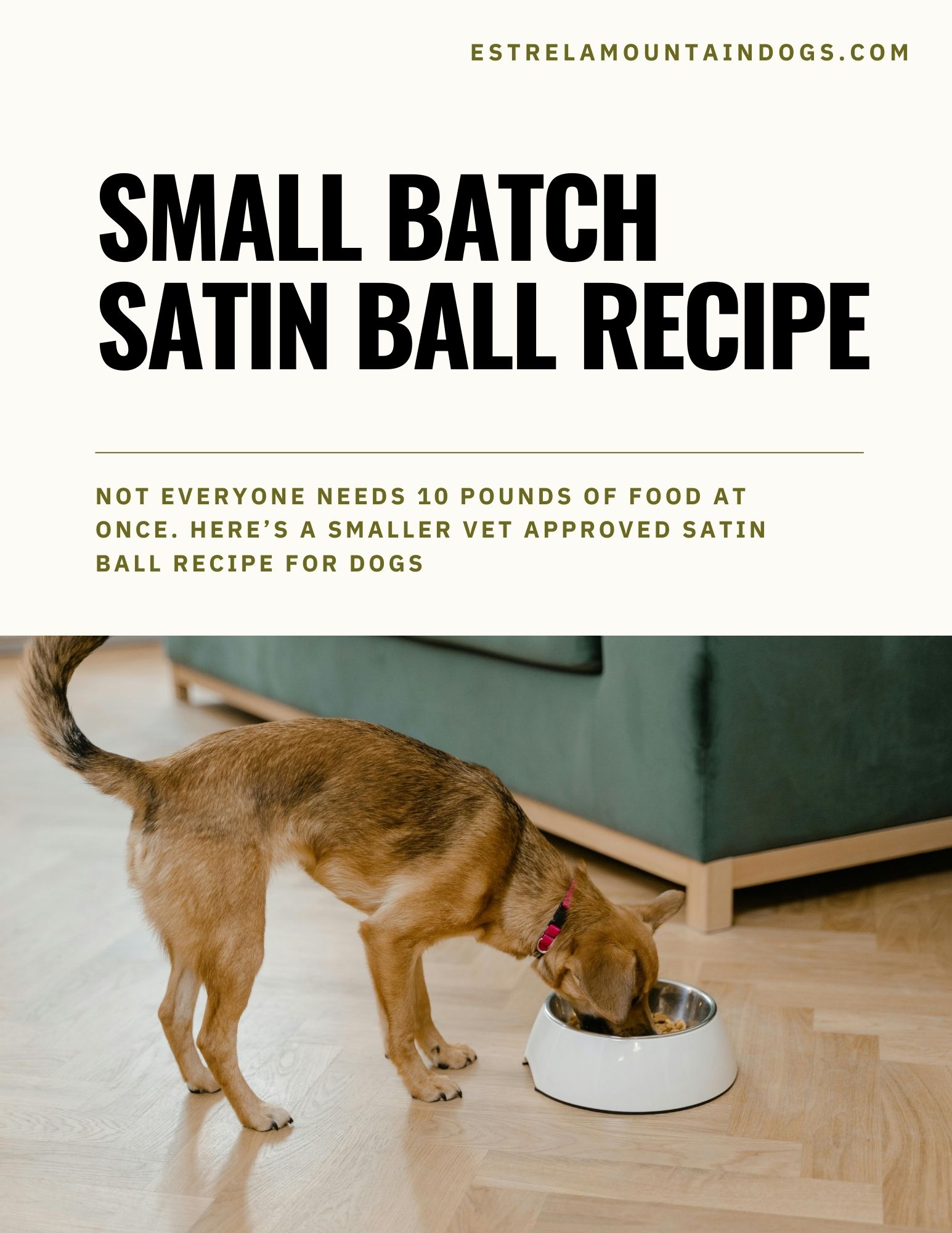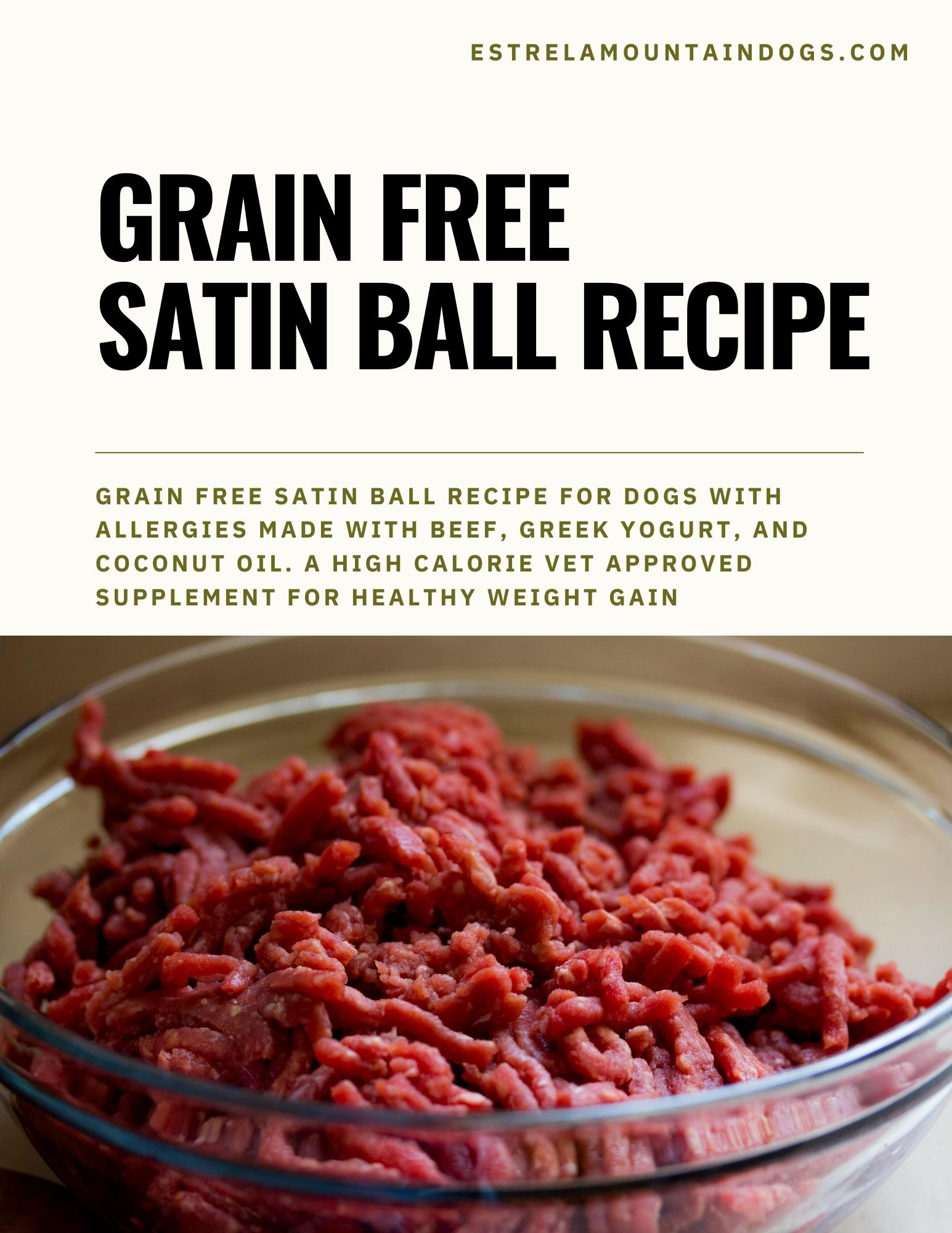
Vet Approved Satin Ball Recipe for Dogs: The Ultimate Weight Gain Supplement
If your dog is struggling to keep weight on, these vet approved Satin Ball recipes for dogs are one of the most effective and trusted solutions you can make at home.This post includes the standard Satin Ball recipe, a scaled-down small batch version, and a grain free option so you can choose the one that best fits your dog’s needs.
The satin ball recipe for weight gain is in most breeders tool box because it provides needed nutrition for nursing dams that are feeding large litters, It is also used for teenage dogs and elderly dogs that need to keep their weight up. This classic mixture of beef, oats, eggs, and coconut oil has been recommended for decades by breeders and veterinarians. With our homemade Satin Ball recipe for dogs, you can help an underweight or active dog gain healthy weight in a safe, natural way.

Vet Approved Satin Ball Recipe for Dogs
Ingredients
Method
- Place all ingredients in a very large bowl.
- Melt coconut oil if it is not in a liquid state
- Mix until the vet approved Satin Ball recipe for dogs is well combined
- Shape into golf ball-sized meatballs. I like to use a lg cookie scoop for this step
- Freeze on trays and then store in freezer bags
- Semi-thaw before feeding
Notes
Feeding Guidelines
- Calorie Count: Approximately 500–600 calories per 4 oz ball (depending on size).
- Frequency: Offer Satin Balls as a supplement, not a complete diet.
- Portion Control: Start slowly, with one ball per day for large dogs and half for smaller dogs, adjusting based on weight goals.
- Consult Your Vet: Especially for puppies, seniors, or dogs with health issues.
Why the Vet Approved Satin Ball Recipe for Dogs Works
The vet approved Satin Ball recipe for dogs is high in calories, protein, and fat. This makes it perfect for:
- Underweight rescues who need extra calories
- Teenagers who are struggling to keep weight on
- High-energy working and guardian breeds
- Nursing mothers who need nutrient-dense food
- Picky eaters who need encouragement
- Males in the breeding season
Because the vet approved Satin Ball recipe for dogs is raw and rich, it is highly palatable and easy for dogs to digest. It also provides quick energy for active dogs.
Vet Approved Satin Ball Recipe for Dogs
Ingredients
- 10 pounds ground beef (high fat, not lean)
- 1 large box Total cereal (about 12 cups)
- 1 large box uncooked oatmeal (about 12 cups)
- 10 raw eggs (with shells finely crushed if desired)
- 1 1/4 cup vegetable oil
- 1 1/4 cup unsulfured molasses
- 10 packets unflavored gelatin
- Pinch of salt
Instructions
- Place all ingredients in a very large bowl.
- Mix until the vet approved Satin Ball recipe for dogs is well combined.
- Shape into golf ball-sized meatballs.
- Freeze on trays and then store in freezer bags.
- Thaw before feeding.
The vet approved Satin Ball recipe for dogs makes a large batch, so freezing is the best way to keep them fresh.
Small Batch Satin Ball Recipe for Dogs
Not everyone needs 10 pounds of food at once. Here’s a smaller vet approved Satin Ball recipe for dogs:

Small Batch of Satin Balls for Dogs
Ingredients
Method
- Combine all ingredients in a very large bowl.
- Mix thoroughly by hand until evenly blended.
- Roll into golf ball-sized portions or form patties.
- Place on a lined tray and freeze until solid.
- Store in freezer bags.
- Thaw as needed and feed raw.
Notes
Feeding Guidelines
- Calorie Count: Approximately 500–600 calories per 4 oz ball (depending on size).
- Frequency: Offer Satin Balls as a supplement, not a complete diet.
- Portion Control: Start slowly, with one ball per day for large dogs and half for smaller dogs, adjusting based on weight goals.
- Consult Your Vet: Especially for puppies, seniors, or dogs with health issues.
Ingredients
- 2 pounds ground beef
- 2 cups oatmeal
- 2 cups Total cereal
- 2 eggs
- 1/4 cup coconut oil
- 1/4 cup molasses
- 2 packets unflavored gelatin
- Pinch of salt
Prepare the smaller vet approved Satin Ball recipe for dogs the same way. It makes about 20–25 treats, perfect for testing the recipe.
How Many Calories are in the Satin Ball Recipe for Dogs?
The typical Satin Ball recipe for dogs is calorie-dense. On average:
- About 500–600 calories per 4-ounce ball
- Packed with protein, fat, and digestible carbs
- This is a weight gain product for dogs
That is why the Satin Ball recipe for dogs is not for overweight dogs, but instead for those who need weight gain or extra energy. The satin balls are very common in breeder circles where we need high calorie supplements to help our dams maintain their weight and still feed a large litter of puppies.
How to Feed the Vet Approved Satin Ball Recipe for Dogs
Always introduce the vet approved Satin Ball recipe for dogs gradually. Start with one small ball per day for large dogs and half a ball for smaller dogs. Adjust based on your veterinarian’s guidance. We like to feed them after the dog has eaten their kibble so that it does not replace their meal.
How Many Satin Balls Can My Dog Eat a Day?
The number of Satin Balls a dog can eat each day depends on their weight, activity level, and how much extra fat you want to add to their diet. These high-calorie supplements are meant to support weight gain, so portion control is important.
- Some owners recommend starting with 2 Satin Balls in the morning with kibble, 1–2 at lunch without kibble, and 1 with dinner, adjusting as needed.
- For example, an 80-pound dog may need on 5 Satin Balls per day (2 in the morning, 1 at lunch, and 2 at dinner).
- A larger 100-pound dog may need 8 Satin Balls daily (3 in the morning, 2 at lunch, and 3 at dinner).
Always remember, the right amount depends on your dog’s size, breed, and metabolism. Satin Balls are a supplement, not a complete diet, so you should monitor your dog’s body condition and adjust portions as necessary. They should not replace a high quality kibble.
👉 Tip: Start with smaller amounts, watch for digestive tolerance, and work with your veterinarian to set the best feeding schedule for your dog.
Satin Ball Feeding Chart
This feeding chart is based on an average Satin Ball containing about 300 calories. Adjust according to your dog’s weight, activity level, and veterinary guidance.
| Dog Weight | Suggested Satin Balls per Day | Example Feeding Schedule |
|---|---|---|
| 20–40 lbs | 1–2 | 1 with breakfast, 1 with dinner |
| 40–60 lbs | 2–3 | 1 with breakfast, 1 at lunch, 1 with dinner |
| 60–80 lbs | 3–4 | 2 with breakfast, 1 at lunch, 1 with dinner |
| 80–100 lbs | 5 | 2 with breakfast, 1 at lunch, 2 with dinner |
| 100–120 lbs | 6–7 | 2 with breakfast, 2 at lunch, 2–3 with dinner |
| 120+ lbs | 8+ | 3 with breakfast, 2 at lunch, 3 with dinner |
Benefits of the Vet Approved Satin Ball Recipe for Dogs
- High calorie and nutrient dense
- Easy to prepare and freeze
- Encourages picky eaters
- Supports recovery and weight gain
- Loved by working and guardian breeds
- Excellent for dams with pups
These benefits are why the vet approved Satin Ball recipe for dogs is so popular among breeders, trainers, and veterinarians.
🌿 Herbs You Can Add to Satin Ball Recipes

While Satin Balls are already nutrient-dense, adding certain herbs can provide extra health benefits for your dog. These natural additions support digestion, immunity, and overall wellness, making them a smart way to customize the recipe for your dog’s needs.
✅ Safe Herbs for Dogs and Their Benefits
- Parsley
- Freshens breath naturally.
- Supports kidney function.
- High in vitamin K, C, and antioxidants.
- Use: 1–2 teaspoons chopped fresh parsley per pound of beef.
- Thyme
- Has natural antimicrobial properties.
- Supports respiratory health.
- Rich in vitamins A and C.
- Use: 1 teaspoon fresh (or 1/4 teaspoon dried) per pound of beef.
- Rosemary
- Natural antioxidant, helps preserve food.
- May support circulation and digestion.
- Adds flavor dogs often enjoy.
- Use: 1 teaspoon fresh (or 1/4 teaspoon dried) per pound of beef.
- Oregano
- Contains natural oils with antibacterial and antifungal properties.
- Supports digestion and immune system.
- Use: 1 teaspoon fresh (or 1/4 teaspoon dried) per pound of beef.
- Basil
- Anti-inflammatory and calming effects.
- Rich in antioxidants.
- Use: 1–2 teaspoons fresh basil leaves, finely chopped.
⚠️ Important Notes on Herbs
- Always use fresh herbs when possible, and chop them finely before adding to the mix.
- Start with small amounts to avoid overwhelming your dog’s digestion.
- Avoid herbs that are toxic to dogs, such as garlic, onion, chives, and nutmeg.
- Herbs are meant to be a supplement, not the base of the recipe.
🌟 Why Add Herbs?
Including herbs in your Satin Ball recipe is an easy way to:
- Improve digestion
- Freshen breath
- Boost immunity
- Provide extra vitamins and minerals naturally
Herbal additions won’t significantly change the calorie content, but they will make the recipe even more functional and health-focused.
🌿 Herb Add-In Chart for Satin Balls
These safe herbs can be added to Satin Ball recipes to provide extra health benefits for your dog. Always start with small amounts and use fresh herbs when possible.
| Herb | Benefits | Safe Amount |
|---|---|---|
| Parsley | Freshens breath, supports kidney health, rich in vitamin K & C | 1–2 tsp chopped fresh per pound of beef |
| Thyme | Antimicrobial, supports digestion & respiratory health | 1 tsp fresh or 1/4 tsp dried per pound of beef |
| Rosemary | Antioxidant, aids circulation & digestion, natural preservative | 1 tsp fresh or 1/4 tsp dried per pound of beef |
| Oregano | Antibacterial, antifungal, supports immune system | 1 tsp fresh or 1/4 tsp dried per pound of beef |
| Basil | Anti-inflammatory, calming, antioxidant-rich | 1–2 tsp fresh chopped per pound of beef |
⚠️ Note: Never use garlic, onion, chives, or nutmeg in Satin Balls, as they are toxic to dogs.
Satin Ball Recipe for Dogs: Frequently Asked Questions
Q: What are Satin Balls for dogs?
A: Satin Balls are a high-calorie, homemade supplement made from beef, fats, and other nutrient-dense ingredients. They’re designed to help underweight or active dogs gain healthy weight.
Q: Are there any drawbacks to cooking Satin Balls?
A: Yes, there can be. Satin Balls were originally designed to be fed raw, since raw feeding preserves certain nutrients and enzymes. Cooking them at high heat may:
- Reduce some of the heat-sensitive vitamins (like certain B vitamins).
- Slightly lower the bioavailability of amino acids in the beef and eggs.
- Change the texture and flavor, which may make them less appealing to some picky eaters.
That said, cooking the Satin Balls does make them safer if you are concerned about raw feeding or bacteria like salmonella. Lightly baking at 350°F for 15–20 minutes is a good compromise — it reduces raw food risks while keeping most of the calories and nutrients intact.
Q: Are Satin Balls safe for all dogs?
A: Satin Balls are generally safe for healthy adult dogs but are not recommended for overweight dogs or those with conditions like pancreatitis. Always consult your veterinarian before starting.
Q: Can Satin Balls be made grain free?
A: Yes. Many owners prefer a grain free Satin Ball recipe for dogs that uses Greek yogurt, coconut oil, and gelatin instead of cereals or oats, making it easier for dogs with allergies or sensitivities to digest. We have a grain free recipe at the bottom of this post.
Q: How many Satin Balls should my dog eat per day?
A: It depends on your dog’s weight and activity level. For example, a 40-pound dog may only need 2 per day, while a 100-pound dog may need 6–8. Always start small, monitor weight gain, and adjust with your vet’s guidance. See the feeding chart in this post.
Q: Should Satin Balls be fed raw or cooked?
A: Satin Balls are traditionally fed raw, but if you prefer, you can lightly bake them at 350°F for 15–20 minutes. Keep in mind that raw feeding preserves more nutrients.
Q: How long do Satin Balls last in the fridge or freezer?
A: Satin Balls should be stored in the freezer for up to 3 months. Thawed Satin Balls will last about 3–4 days in the refrigerator.
Q: Can puppies eat Satin Balls?
A: Puppies can eat Satin Balls in very small amounts, but talk to your veterinarian. Because they are calorie-dense, it’s important not to overfeed.
Q: Are Satin Balls a complete diet?
A: No. Satin Balls are a supplement and should be fed alongside a balanced dog diet such as kibble, raw, or home-cooked meals.
Q: Is there anything I can use to replace Total cereal and wheat germ in Satin Balls? My dog is skinny but allergic to wheat, corn, and yeast.
A: Yes, you can substitute those ingredients. Total cereal and wheat germ in the original recipe are mainly there to provide fiber, bulk, and trace vitamins and minerals. If your dog has allergies to wheat, corn, or yeast, you can use grain-free alternatives such as:
- Rice cereal (gluten-free, gentle on digestion)
- Ground flaxseed (adds fiber and omega-3 fatty acids)
- Coconut flour or almond flour (grain-free binders, rich in nutrients)
- Rolled oats (certified gluten-free) — if tolerated
These swaps keep the recipe effective for weight gain while making it safe for dogs with allergies. Always introduce new ingredients gradually and consult your vet if your dog has ongoing digestive issues.
Q: My mentor suggested giving Satin Balls to my bitch who just whelped 10 puppies, but she has diarrhea. What can I do?
A: While Satin Balls are a great calorie boost for nursing moms, the richness of the recipe can sometimes cause or worsen diarrhea. Since your bitch is caring for a large litter, it’s important to support her digestion and hydration right away.
You can:
- Pause or reduce Satin Balls temporarily and reintroduce in smaller amounts once stools firm up.
- Add probiotics daily to help restore gut balance and support her immune system. Breeders often use products like FortiFlora, Probios Powder or Gel, or Dogzymes Probiotic Max during lactation.
- Offer electrolytes in her water to keep her hydrated and replace what she’s losing through diarrhea. Safe breeder options include Re-Sorb Electrolyte Solution (Farnam), Pet-A-Lyte (Revival Animal Health), or Revive Electrolyte mixes. Always provide plain water alongside so she has a choice.
- Feed smaller, more frequent meals that are easier to digest while still delivering calories.
⚠️ Important: If her diarrhea continues for more than 24–48 hours, or she shows signs of dehydration, weakness, or loss of appetite, contact your veterinarian immediately. With 12 puppies relying on her, quick action is critical.
Q: Do I have to add the egg shells to Satin Balls?
A: No, but it’s a simple way to add extra calcium. You can just toss the raw egg shells straight into a blender with the other ingredients and they’ll grind down easily into the mix. This saves time and makes the shells more digestible. If you prefer, you can leave them out — the recipe still works fine without them — but many breeders include shells for the extra mineral boost, especially for nursing bitches or growing dogs.
Can I feed a dog Satin Balls for milk production?
A: Yes , if she is a healthy dog, raw Satin Balls are safe. These recipes were originally created to be fed raw, and a dog’s immune system is naturally designed to handle raw meat. For a dam with puppies, the dense calories, fats, and proteins in raw Satin Balls can be a valuable boost to support her recovery and milk production.
That said, if your dog has never been fed raw before, it’s best to introduce Satin Balls slowly. Start with a small amount mixed into her regular diet and increase gradually. This allows her digestive system to adjust while still giving her the calorie support she needs.
We need to trust dogs’ natural resilience — their immune systems are built for this. The key is starting carefully and monitoring her condition as you go.
Storage Tips for the Vet Approved Satin Ball Recipe for Dogs
- Store frozen for up to 3 months
- Keep thawed portions in the fridge for 3–4 days
- Serve thawed, raw, or lightly baked if preferred
Grain-Free Satin Ball Recipe for Dogs
For dogs with allergies or sensitivities, the grain free Satin Ball recipe for dogs offers all the benefits of the original version without the grains that can sometimes trigger digestive or skin issues. We do not feed grain free to our healthy Estrela Mountain Dogs because we know that grains are an important part of a healthy dogs diet. But this version is perfect for a dog that is struggling with gut issues, allergies, cancer, thyroid issues or any issue that prevents them from eating the standard recipe. This variation uses Greek yogurt in place of cottage cheese and skips grains like oats or cereal, making it a simple, nutrient-dense option for dogs who need help gaining weight.
One of the standout benefits of the grain free Satin Ball recipe for dogs is the addition of Greek yogurt. Not only does it provide extra protein and fat, but it also introduces natural probiotics that support gut health and digestion. This makes the recipe both calorie-dense and beneficial for dogs with sensitive stomachs.
Because this mixture is designed to be fed raw, it’s extremely easy to prepare and store. Simply roll the mixture into meatballs, freeze them, and thaw as needed. Each ball packs around 270 to 400 calories, depending on size, so it’s important to feed them as a supplement rather than a complete diet. Most owners use them alongside regular kibble or raw meals to boost calorie intake without overwhelming the dog’s system.
Overall, the grain free Satin Ball recipe for dogs is a way to support healthy weight gain in a version that’s gentle on dogs with allergies, have cancer or have other thyroid issues that prevent them from eating the regular recipe.

Grain-Free Satin Balls Recipe for Dogs (Greek Yogurt Version)
Ingredients
Method
- Instructions
- Place the ground beef in a large mixing tub or bowl.
- Add Greek yogurt, olive oil, molasses, eggs, gelatin, and salt.
- Mix thoroughly by hand until everything is well blended.
- Form into golf-ball sized meatballs (about 2–3 oz each).
- Freeze on trays lined with parchment paper.
- Transfer to freezer bags and store up to 3 months. Thaw before serving.
Notes
The Balance Between Health and Weight Gain
In most cases, veterinarians and breeders agree that steady, healthy weight maintenance is far better than rapid weight gain. Dogs that carry excess fat can face higher risks of joint strain, heart stress, and digestive upset. For companion dogs with moderate activity levels, keeping them lean is one of the best things you can do for long-term health and mobility.
That said, there are times when intentional weight gain becomes necessary — and that is where the Satin Ball recipe for dogs can be a useful tool. Underweight rescues who arrive malnourished, working dogs who burn more calories than they can replace, or dams nursing large litters all fall into this category. In these situations, extra calories are not just a luxury, but a requirement for survival, recovery, or performance.
For example, a nursing bitch with 10 or more puppies may lose condition quickly if her calorie intake doesn’t keep up with the demands of lactation. This not only affects her health but also the quality and quantity of milk the puppies receive. Likewise, a malnourished rescue may not be able to rebuild strength on kibble alone. A concentrated calorie source helps restore body condition more quickly so they can transition into a balanced diet.
The key is recognizing that Satin Balls are a supplement, not a long-term feeding strategy. They should be used for a season — when a dog needs help — and not as an everyday treat for a healthy pet. By using them thoughtfully, owners and breeders can address short-term needs without encouraging long-term obesity.
This is why the Satin Ball recipe for dogs has remained popular: it fills a very specific role. It is not about routine feeding, but about providing an effective calorie boost when it matters most.
Final Thoughts on the Vet Approved Satin Ball Recipe for Dogs
When your dog needs extra calories, the vet approved Satin Ball recipe for dogs is a proven, trusted choice. Easy to prepare, budget-friendly, and effective, this recipe has helped countless dogs gain weight safely. Always check with your veterinarian before starting the vet approved Satin Ball recipe for dogs, especially for puppies, seniors, or dogs with special health needs.
By making the vet approved Satin Ball recipe for dogs, you’re giving your pup a natural, nutrient-rich boost that supports energy, weight, and overall health.
👉 Have you tried Satin Balls before? Share your experience in the comments — your story might help another dog owner!
🐾 Other Posts You Might Like
- Homemade Vet-Approved Dog Treats Recipe
- Best Feeding Practices for Livestock Guardian Dogs
- Best Whelping Boxes for Large Dogs
- Raising Healthy Puppies: Nutrition Tips for Breeders
- Grain Free Diets for Dogs: Pros and Cons
Health Links for Satin Ball Recipe for Dogs
- Molasses (Blackstrap) – Source of iron, B vitamins, and natural energy support.
Volhard Dog Nutrition - Molasses Mineral Benefits – Provides calcium, magnesium, potassium, and immune support when used in moderation.
DialaVet - Egg Nutrition for Dogs – Eggs are nutrient-dense, offering protein, fatty acids, vitamins, and minerals.
PetMD - Greek Yogurt Benefits – Adds probiotics, calcium, and protein to support gut and immune health.
Just Food For Dogs - Gelatin for Dogs – Supports joint health, digestion, and nutrient absorption.
Custom Collagen - Gelatin and Mobility – Shown to improve stiffness and mobility in dogs with arthritis.
Science Publications - Coconut Oil Benefits – Supports skin, coat, brain health, and provides healthy fats for energy.
AKC - Coconut Oil Safety – Must be fed in moderation to avoid digestive upset or weight gain.
PetMD - Grain-Free Diets and Allergies – Some dogs benefit from reduced grains for allergy management.
PetMD - Treat Calorie Guidelines – Treats like Satin Balls should make up no more than 10% of daily calories.
AKC
Comments +